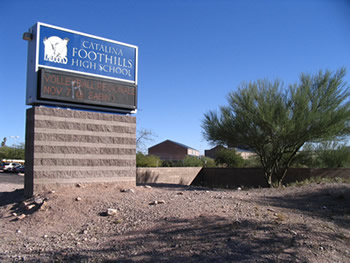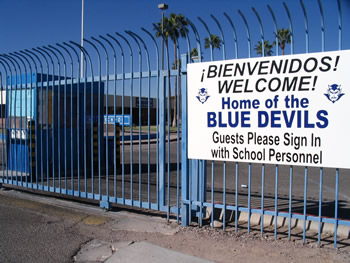|
Visual Experiment
As a service-learning coordinator, I saw the svr2 event as a means for recruiting Graduate Teaching Associates and adjuncts to participate in Wildcat Writers, the University of Arizona Writing Program's service-learning initiative that partners First-Year Composition (FYC) courses with local high-school English classes for semester-long student writing exchanges. After all, what better way to encourage “spatial and visual analysis” in the FYC classroom than by asking teachers to participate in a program that encourages students to visit local places? However, my desire to convince busy instructors to participate in service learning led me to frame the high schools in a way that highlighted their differences and disadvantages. For example, I considered showing images of local high schools from different areas of Tucson (both low- and middle-income) to prompt analysis of power relations structuring and structured by school layout and design. Yet, as I moved through the Spatial and Visual Rhetorics graduate course readings, I became increasingly aware of the need to complicate my position as a representative of the service-learning initiative and of the local schools. Further, I began to question the function of visual representations in constructing outsiders’ assumptions about places and the people who inhabit those places. Finally, I began to think critically about my college students’ experiences when visiting local schools and their assumptions about those places and the people there—an experience I have come to call “spatial shock.”
In short, the SVR course effectively messed with my head, inspiring me to think critically about place/space, power relations, the politics of representation, and service-learning practices. Rather than try to resolve the contradictions of my role as a representative of underserved high schools in the area, I decided to use the tension to complicate others’ understandings of and assumptions about place, space, and power while encouraging a spatial rhetorical practice I tentatively call strategically social strolling.
Thus, this webtext, like the installation I created for the event, is a service-learning administrator’s movement through theories of representation, space, place, and spatial shock. Here, I lay out my arguments in much the same way as the original installation (with the links representing what was a different turn or point in the installation), but I take advantage of what my colleague Ashley Holmes sees as an opportunity of web technologies, to “decelerate” and reflect more explicitly about the choices I made during this project and the terms I employ. I encourage viewers to begin with the visual experiment below, but also to engage the links in creative ways, transgressing tendencies of linearity in reading webtexts.
Seeing Place: A Visual Experiment
 
Take a moment to view these alternating images of the entrances to Catalina Foothills High School (left) and Sunnyside High School (right) in Tucson, Arizona. As you move your mouse over the images, they will change to give you a fuller sense of the front of the schools—first the welcome signs and then the gated entrances that lead to classrooms. Compare your visceral responses to each setting, and contemplate your assumptions about how each place constructs or shapes students’ experiences there.
Background image credit: Joe
Schumacher
|

